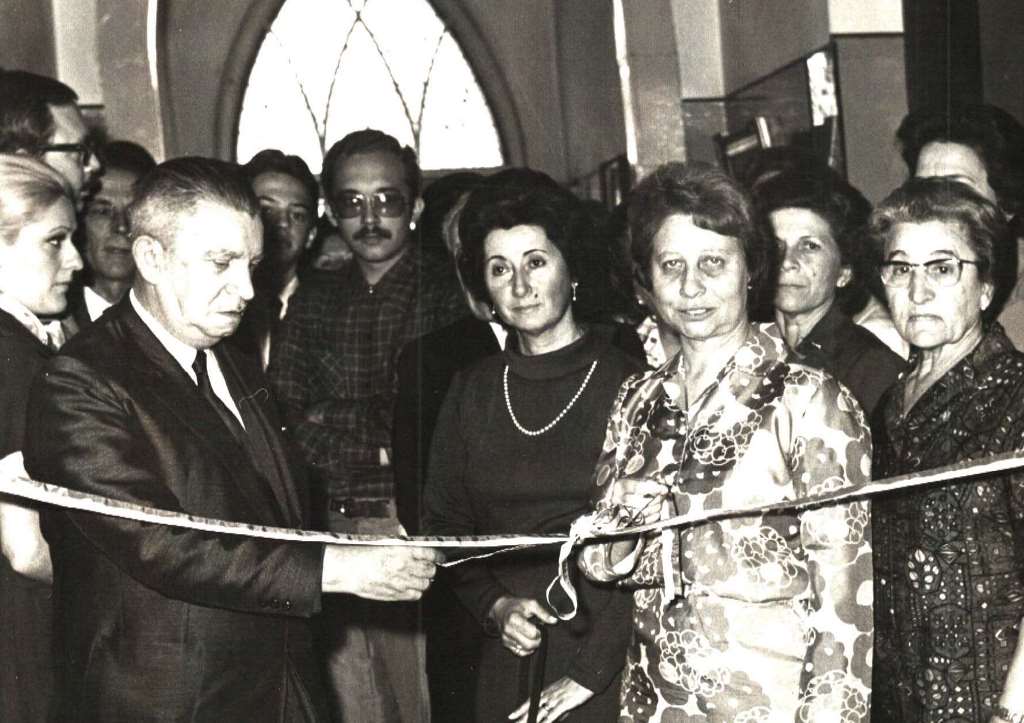
The trajectory of the System of Museums of the State of São Paulo (its previous name) started officially in the year of 1986, with its foundation through the n. 26,634 Decree, signed on January 13 by the Governor Franco Montoro, the Secretary of State for Culture, Jorge da Cunha Lima and the Secretary of State for Government, Luiz Carlos Bresser Pereira, resulting into the first system of museums in the nation.
The idea of the System came up in the context of the Brazilian political reopening, in the process of the liberalization of the military dictatorship and empowerment of the civil society. It can be noticed the foundation of the State System of Archives and the State System of Libraries before the System of Museums, during the management of the Secretary of State, Cunha Lima.
Professor Vinício Stein Campos and Jocely Stolf inaugurate the room “História de Piracicaba”,
at the Prudente de Moraes MHP (4/11/971)
The debate about the creation of “systems” referred to the appreciation and enhancement of the cultural institutions of the state and the cities, through actions of formation, training and technical improvement, but also in the perspective of an integrated approach and democratic institutional development, respecting the juridical-administrative, cultural and technical autonomy. The aims of the Decree of Foundation of the System of Museums in 1986 will, therefore, mirror these premises related to the association among the state museums, the establishing of ordinary programs of work, the stimulation of the democratic participation from the different segments of the society.
Understanding the elements that worked as conditions for the foundation of the System of Museums of the State of São Paulo, in the 1980s, cannot be separated from the first web of state museums, the Historical and Pedagogical Museum Web. Such set of museums take us back to the 1950s, when it was started by Sólon Borges dos Reis, general director of the Education Department of the Secretariat of State of Education Business, who proposed, in 1956, the introduction of the HPMs in the state. This proposal, put forward to the Secretary of State Vicente de Paula Lima, through the n. 26,218 Decree, on August 3 1956, included the foundation of the first Historical and Pedagogical Museums: Prudente de Moraes HPM (Piracicaba), Campos Salles HPM (Campinas), Rodrigues Alves HPM (Guaratinguetá) and Washington Luís HPM (Batatais). In 1957, Sólon Borges dos Reis invited Vinício Stein Campos to be the president of the Historical Museums Service, making him responsible for the introduction and management of the Historical and Pedagogical Museums. For 17 years (1956 to 1973), 79 institutions were conceived and organized, resulting in the Historical and Pedagogical Museums Web, and 57 of them were effectively founded. At their introduction, remarkable informal agreements were made with the local prefectures for sharing the management of those museums.

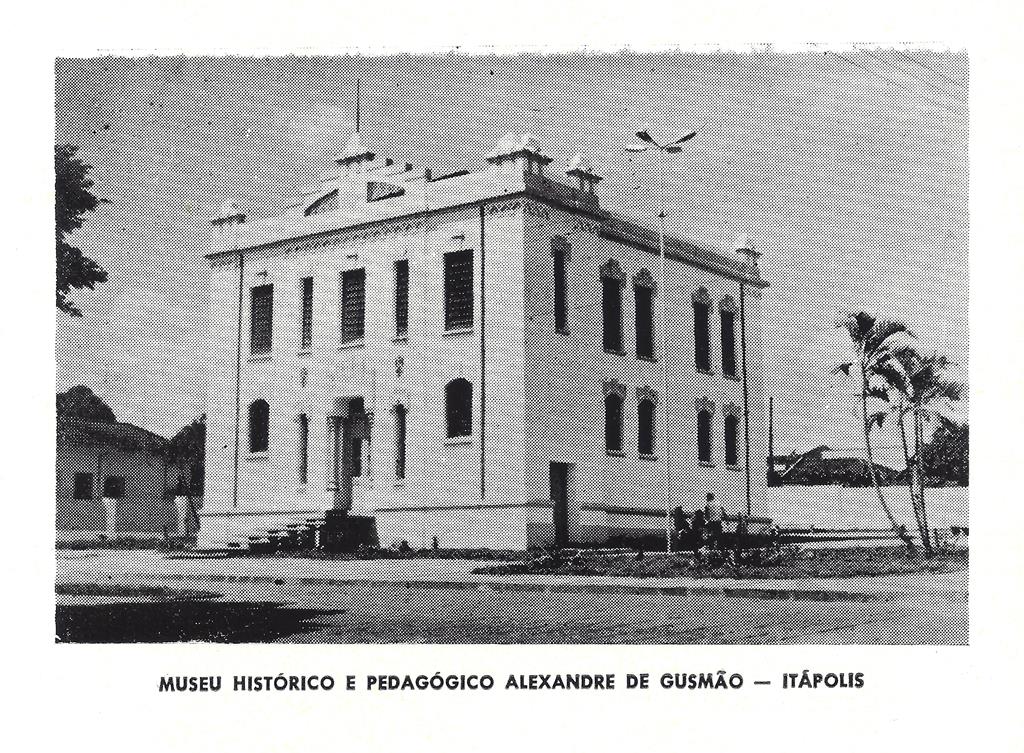

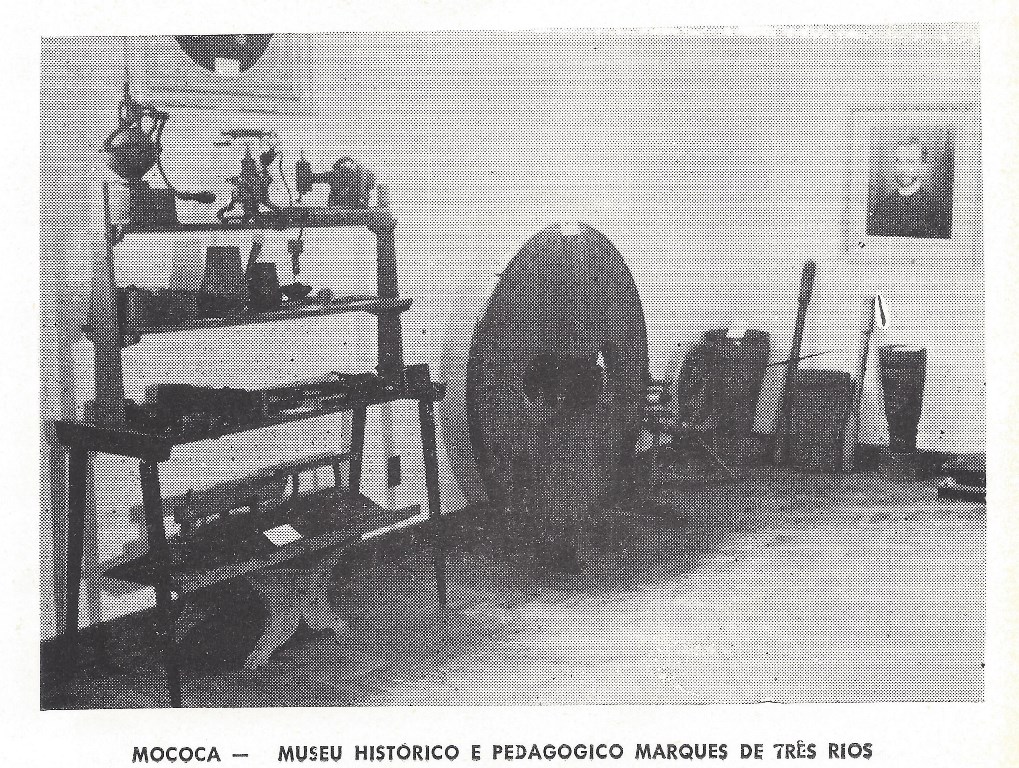
In 1979, the Historical and Pedagogical Museums Web was transferred to the Secretariat of Creative Culture, Economy and Industry, which had been just founded. In 1980, the Commission for the Stimulation of Museums was set up by the Secretary of Culture, Cunha Bueno. Such initiative came up as a response to the demand of the municipal managers of the inland cities of the State, who complained about the fragile situation of the Historical and Pedagogical Museums at that time. From this moment on, a series of actions aiming the qualification and enhancement of the museological institutions from the state began, especially the ones located in the inland cities. The Commission for the Stimulation of Museums, just after their foundation, had to visit the museums in the inland cities of the state, aiming to diagnose the state of these institutions carefully. In their first analysis, the Commission suggested the municipalisation of a good amount of them, with the objective of donating legally their collections to the cities which held them, once it showed to be impossible to manage such a great amount of institutions, mainly because the local character of most of them.
Even though the state government comprehended the municipalisation of these museums was the best way to solve the problems caused by the non-definition of the management, they also knew that, as such museums’ management was transferred to their own cities, they would really need the State’s technical support. As it was not the state government’s responsibility to care for the expenses of these institutions, it was thought that the government would be able to work in a structural way, developing training actions and technical support for the museums, enhancing them and intensifying their autonomy. At the same time, there was the intention of stimulating local and regional synergies, in other words, the intention of promoting the dialogue among the cultural institutions for mutual support. From these idealizations and needs, the System of Museums of the State of São Paulo was then formed, being officially founded in 1986, creating a Technical Group of Coordination of the System (later called by the Portuguese initials, GTC SISEM-SP), as well as the System itself. The GTC SISEM-SP had Diná Terezinha Camarinha Queiroz Jobst as the first director, and she kept her role for twenty-two years (1986-2008), Cecília Machado came after her (2008-2011), Renata Viera da Motta (2011-2013) and Davidson Panis Kaseker, the current director.
During the recent researches about this theme, it was noticed that the creation of the System of Museums was the result of a long discussion on the real role of these museums from the inland cities of the state, asking about the eventual future which was aimed for them and for the action of the state in favour of the museological Paulista heritage in general. An unassailable issue related to these institutions is that, in spite of the controversial context of their creation, introduction and initial organization, and disputable methodologies of conception under the museological perspective, they have become really fertile tools for giving rise to a deep reflection on the role of the State and prefectures before their museums, as much as about their conceptual aspects and public management.
If the historical analysis showed great emphasis on the work of the System for the training and technical support, it was noticed that would be necessary to rethink about the System’s acting among the museums, which would demand necessarily the recognition of the need of enhancing the dialogue between the museums and the System. A decisive point in the process of revitalization of the System of Museums of the State of São Paulo, which resulted in the edition of its new decree, was the resumption of the actions of linking the museums altogether, and, especially, the creation of the Paulista Museums Meeting, in 2009. This event, currently, has become the greatest meeting for museological connection in São Paulo, aiming to gather the museums from the state, promoting their actions and exchange among them. It tries to stimulate the enhancement of the regional institutions and the exchange of information and knowledge among them. In 2016, the year of celebration of the 30th anniversary of the State System of Museums, the event had as main theme “Webs and Systems of Museums: Collaborative Actions”. In previous editions, the Meeting also included themes like: “To be different. Make the difference” (2010); “Connecting Territories” (2011); “New Boundaries of the Management of Museums” (2012); “Process of Resignification of Museums” (2014) and “Museums: Forum of Communities” (2015).


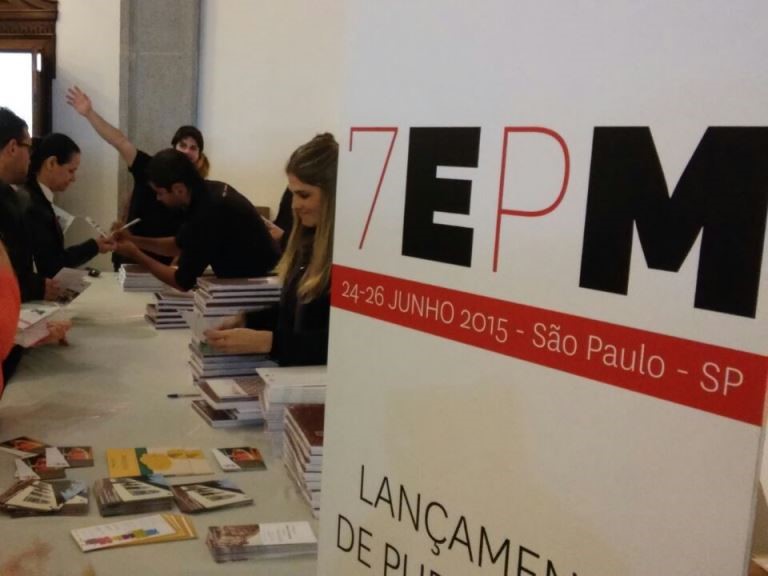
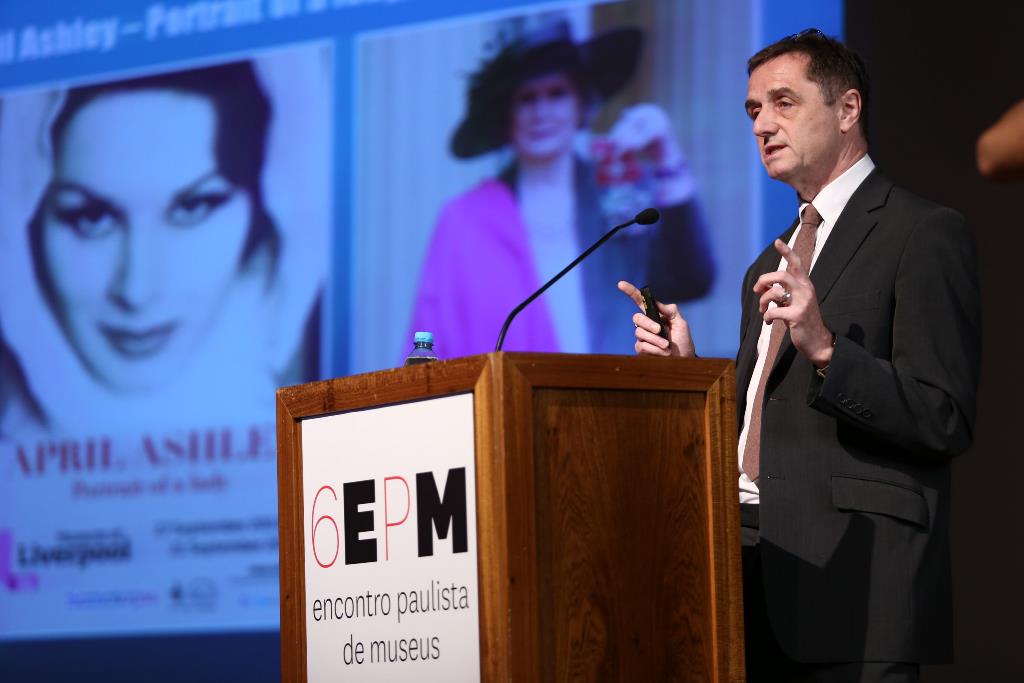
In addition to promoting the meeting among the professionals of museums, allowing them to get to know each other, there were still some steps to be taken. The next stage was to recognize that the contributions for the restructuring of the System could also come from outside the Technical Group environment. In this manner, by resetting the structure of the museological poles and their respective representors, a new logic of regional representation was chosen, following the division developed by the SEADE Foundation and used by several other organs of the government for planning the different sectors. For that, it was intended to form a group that could assist in the discussion on the restructuration of SISEM-SP’s work. It was then created the initial group of the future Working Group of Regional Representations.
In 2011, after more than two decades of working, the System of Museums of the State of São Paulo consolidated its reformulation, through the n. 57,035 Decree, of June 2, 2011. More than adopting the new title, State System of Museums of São Paulo (SISEM-SP), the Decree promoted adequacy to the rules proposed on the Statute of Museums (Federal Law n. 11,904, from January 14, 2009). In addition to that, an analysis of the previous work of the System started to be done so that the future actions could be planned. In this new phase, the set of actions of SISEM-SP were redefined: connection, technical support, training, communication and promotion.
Still in 2011, with the creation of the action of the SISEM-SP “Promotion”, a negotiation started with the Unit of Promotion and Diffusion of the Cultural Production (UFDPC) to create a specific edict to support museums, what happened the following year when the first edict of the Secretariat of Creative Culture, Economy and Industry was published, focused on museological collections, providing R$ 550 thousand for projects of diffusion and preservation of museological collections. It can be said that 2012 was the year for consolidating forms and ways of actions, as well as institutional structuring of SISEM-SP. The following years, the value allocated for projects was doubled, making a total of R$ 4.95 million investment in the requalification of the museums from São Paulo..
In 2012, the GTC SISEM-SP continued the process of updating and institutional consolidating the State System of Museums, by publishing the legal structuring rules and in processes of elections of representors of areas. Therefore, the formation of the Group of Work (N. 96 SC Resolution, from October 03, 2012), with the election of regional representations, and the Committee of Guidance of SISEM-SP (N. 60 SC Resolution, from August 27, 2012), which has representors elected directly by the contestants of the Paulista Museums Meeting, representor of public universities from São Paulo, representor of the Technical Course of Museology and representors of the organs which manage public policies for SEC-SP museums, which was unprecedented, materializing a process of connection and representation of the museological area of the State which started in 1986. Through the promotion of connectivity, it was aimed a participative discussion on the premises and directives of the cultural policy for the museological sector in the State of São Paulo.
Currently, as it was proposed in its creation, the State System of Museums of São Paulo gather and connects the museums in the state of São Paulo, aiming to promote the qualification and institutional enhancement for the preservation, research and diffusion of the Paulista museological collection. Working systematically for sharing responsibilities, the GTC SISEM-SP has structured their work around participative premises, promoting interaction among advisory and deliberative institutions. This way, between 2013 and 2016, the activity of developing the State Database of Museums involved the Committee of Guidance of SISEM, which mixes representors of the government and the civil society, the Group of Work of the Regional Representors. It was also organized two face-to-face public consultations, one involving the state museums and another the other institutions from the section, as well as an online public consultation open to the participation of people who may be interested in the matter.
Therefore, the introduction of the State Database of Museums (CEM in Portuguese initials) – which was released during the 8th Paulista Meeting of Museums, in 2016 – is under development, setting the criteria for the qualification of the institutions which will be part of SISEM-SP, ensuring, then, the definition of minimal parameters by which the institutions will be assessed, especially to know is they work effectively as consolidated museological processes. The definition of these parameters is essential to guide the public policy for the sector and even for the definition of actions to be done for the qualification of the museological scenery of the state. It is predicted here the possibility of starting a new cycle of public policies for the Paulista museums. The State Database of Museums, the way it is planned, will be an important tool to map out and guide the work of the museums from São Paulo, and certainly a compass for the following years of SISEM-SP.
In addition to the impact that the norms that will be set by the State Plan of Culture will reach directly the Paulista museological sector, it is necessary to consider, that, still keeping the same logical idea of the National System of Culture, São Paulo will probably suggest the debate about the development of the Sectorial State Plan of Museums, which will be done through a set of guidelines, strategies, actions and goals that will highlight the most important proposals for the museums, in harmony with the other regulations of the cultural field for both the state and the federal ambits, becoming, then, as the main tool of consolidation, institutionalization and introduction of a public policy for the Paulista museological sector.
By: Ana Carolina Xavier Avila, Davidson Panis Kaseker and Luiz Fernando Mizukami
Watch the celebration video for the 30th anniversary of SISEM-SP:
